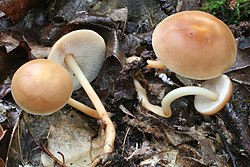Gymnopus dryophilus
Species of fungus From Wikipedia, the free encyclopedia
Gymnopus dryophilus is a mushroom commonly found in temperate woodlands of Europe and North America. It is generally saprophytic, but occasionally also attacks living wood. It belongs to section Levipedes of the genus, being characterized by a smooth stem having no hairs at the base (in contrast to section Vestipedes).[1][2] Until recently it was most frequently known as Collybia dryophila.
| Gymnopus dryophilus | |
|---|---|
 | |
| Scientific classification | |
| Domain: | Eukaryota |
| Kingdom: | Fungi |
| Division: | Basidiomycota |
| Class: | Agaricomycetes |
| Order: | Agaricales |
| Family: | Omphalotaceae |
| Genus: | Gymnopus |
| Species: | G. dryophilus |
| Binomial name | |
| Gymnopus dryophilus | |
| Synonyms | |
|
Agaricus dryophilus | |
| Gymnopus dryophilus | |
|---|---|
| Gills on hymenium | |
| Cap is convex | |
| Hymenium is adnexed or free | |
| Stipe is bare | |
| Spore print is white to cream | |
| Ecology is saprotrophic | |
| Edibility is not recommended or unknown | |
Description
Summarize
Perspective
The cap is 2–6 centimetres (3⁄4–2+3⁄8 in) in diameter, convex, and reddish-brown to ochre (fading to tan with dryness); they become more irregular in shape with age.[3] The gills, which are only thinly attached to the stem (detaching with age),[3] are whitish and crowded. The spore powder is white; the buff spores do not react in Melzer's reagent.[3] The bald stem ranges from 2–8 cm (3⁄4–3+1⁄8 in) long by 3–6 mm 3–6 mm (1⁄8–1⁄4 in) in diameter, sometimes thicker at the base.[3][4][5][6][7] The taste is palatable.[3]
Microscopically the spores are 6×3 μm in size and slightly tear-shaped, there are lobed club-shaped cystidia (15–50 μm × 2–6 μm), and the hyphae on the cap cuticle can also have lobes. It is contended that G. dryophilus in fact consists of a complex of different species and that several new species (including G. brunneolus, G. earleae and G. subsulphureus) should be split off from it.[8] However these species are not generally recognized at present.[9]
The species may carry the parasite Syzygospora mycetophila, which causes pale growths on the mushroom surface.[3]
Similar species
Outside of its genus, it may resemble Marasmius strictipes.[10] Additionally, Rhodocollybia butyracea[7] has a pinkish spore deposit, and some of the spores turn reddish-brown in Melzer's reagent.[3]
Distribution and habitat
This fungus is very common in Northern Hemisphere temperate woodlands (so much so that it is sometimes considered a "weed" mushroom).[8] It fruits from April to December[11] and is often seen when there are few other fungi in evidence. Although the Greek epithet dryophilus means "lover of oak trees", it is also found with other broad-leaved trees and with conifers.
Grows in arcs and fairy rings in oak and pine woods, or as clusters on wood chip mulch from May to October.[12]
Edibility
Gymnopus dryophilus contains toxins which may cause severe gastrointestinal issues.[13] However, it has been listed as edible by some sources, though not worthwhile.[5][14] It is recommended not to eat the stem, which is tough.
It has been found to contain anti-inflammatory beta-glucans.[15]
The mushroom has a sweet nutty flavor and should not be eaten in contaminated places like industrial or near roads due to its capacity to take up mercury. It is edible but may cause gastrointestinal issues in some people.[12]
References
External links
Wikiwand - on
Seamless Wikipedia browsing. On steroids.
